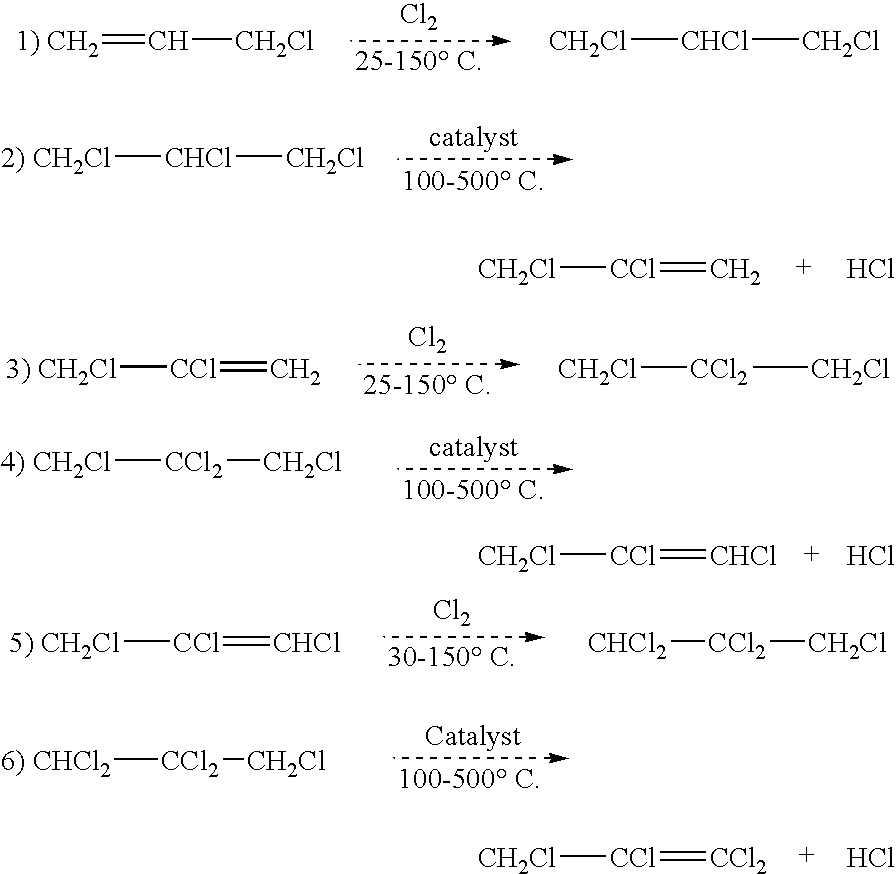Processes for preparing 1,1,2,3-tetrachloropropene
a technology of tetrachloropropene and chlorinated olefin, which is applied in the field of chlorinated olefin preparation, can solve the problems of process deterioration, and inability to meet the requirements of manufacturing operations,
- Summary
- Abstract
- Description
- Claims
- Application Information
AI Technical Summary
Benefits of technology
Problems solved by technology
Method used
Image
Examples
example 1
Synthesis of CH2ClCHClCH2Cl from Cl2 and CH2ClCH═CH2
[0019]A 250 mL three-necked flask is equipped with stir bar, thermometer, reflux condenser cooling with −50° C. cooling fluid, and Cl2 inlet which is connected to a flow meter and then a Cl2 feed cylinder. The top of the condenser is connected to a scrubber to treat any un-reacted Cl2. The reactor is heated in an oil bath to control inside temperature to about 45° C.-50° C. About 100 g of CH2═CHCH2Cl is added to the flask, and then Cl2 is bubbled into the CH2═CHCH2Cl at a rate of about 5 to about 10 grams per hour while the mixture is continuously stirred. The progress of the reaction is monitored by gas chromatography. Chlorination is continued until the conversion of CH2═CHCH2Cl is about 95% or greater, and the major component in the reaction product is CH2ClCHClCH2Cl, which is preferably present in an amount of at least about 90 mole % of the reaction product.
example 2
Synthesis of CH2ClCCl═CH2 from CH2Cl—CHClCH2Cl
[0020]A ½″ OD×36″ long reaction tube is prepared by charging the tube with about 65 cc of Cr2O3 catalyst. A thermocouple is inserted into the center of the catalyst bed to monitor reaction temperatures. A coiled section of 10 ft length of ¼″ OD monel tube is connected to the reactor inlet and serves as a vaporizer / superheater for the organic feed that is being introduced. The vaporizer and reaction tube are heated by a sand bath until the catalyst bed temperature is about 350° C. CH2ClCHClCH2Cl, preferably as produced by the reaction product of Example 1, is fed (preferably via a peristaltic pump) at a rate of about 9 to about 10 grams per hour. Product is collected in a cold trap (product collection cylinder) for a total of about 2 hours. The organic recovered is analyzed using GC. The GC results show about 90% or greater conversion of CH2ClCHClCH2Cl. The major product is CH2ClCCl═CH2, preferably being present in the reaction product in...
example 3
Synthesis of CH2ClCCl2CH2Cl from CH2ClCCl═CH2 and Cl2
[0021]The same reaction apparatus as in Example 1 is used. The reactor is heated in an oil bath to control the inside temperature of from about 45° C. to about 50° C. About 100 g of CH2ClCCl═CH2 is added to the flask. Chlorine is bubbled into the CH2ClCCl═CH2 at a 5-10 grams per hour. The reaction is allowed to proceed until a 85% or greater conversion of CH2Cl—CCl═CH2 is achieved, and the major product is CH2ClCCl2CH2Cl, which in preferred embodiments is present in the reaction product in amounts of from about 85 mole % or greater.
PUM
| Property | Measurement | Unit |
|---|---|---|
| temperature | aaaaa | aaaaa |
| temperature | aaaaa | aaaaa |
| temperature | aaaaa | aaaaa |
Abstract
Description
Claims
Application Information
 Login to View More
Login to View More - R&D
- Intellectual Property
- Life Sciences
- Materials
- Tech Scout
- Unparalleled Data Quality
- Higher Quality Content
- 60% Fewer Hallucinations
Browse by: Latest US Patents, China's latest patents, Technical Efficacy Thesaurus, Application Domain, Technology Topic, Popular Technical Reports.
© 2025 PatSnap. All rights reserved.Legal|Privacy policy|Modern Slavery Act Transparency Statement|Sitemap|About US| Contact US: help@patsnap.com

